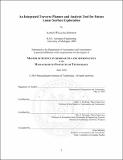| dc.contributor.advisor | Jeffrey A. Hoffman and Dava J. Newman. | en_US |
| dc.contributor.author | Johnson, Aaron William | en_US |
| dc.contributor.other | Massachusetts Institute of Technology. Dept. of Aeronautics and Astronautics. | en_US |
| dc.date.accessioned | 2010-10-29T13:51:01Z | |
| dc.date.available | 2010-10-29T13:51:01Z | |
| dc.date.copyright | 2010 | en_US |
| dc.date.issued | 2010 | en_US |
| dc.identifier.uri | http://hdl.handle.net/1721.1/59560 | |
| dc.description | Thesis (S.M.)--Massachusetts Institute of Technology, Dept. of Aeronautics and Astronautics, 2010. | en_US |
| dc.description | This electronic version was submitted by the student author. The certified thesis is available in the Institute Archives and Special Collections. | en_US |
| dc.description | Cataloged from student submitted PDF version of thesis. | en_US |
| dc.description | Includes bibliographical references (p. 161-168). | en_US |
| dc.description.abstract | This thesis discusses the Surface Exploration Traverse Analysis and Navigation Tool (SEXTANT), a system designed to help maximize productivity, scientific return, and safety on future lunar and planetary explorations,. The goal of SEXTANT is twofold: to provide engineers with a realistic simulation of traverses to assist with hardware design, and to serve as an aid for astronauts that will allow for more autonomy in traverse planning and re-planning. SEXTANT is a MATLAB-based tool that computes the most efficient path between user-specified Activity Points across a lunar or planetary surface for a suited astronaut or transportation rover. Currently, SEXTANT uses an elevation model of the lunar south pole generated from topography data from the Lunar Orbiter Laser Altimeter instrument aboard the Lunar Reconnaissance Orbiter. The efficiency of a traverse is derived from any number of metrics: the path distance, time, or the explorer's energy consumption. Energy consumption is either the metabolic expenditure of an astronaut or the power usage of a transportation rover over the terrain. The user can select Activity Points and visualize the generated path on a 3D mapping interface. The capabilities of SEXTANT are further augmented by the Individual Mobile Agents System (iMAS) astronaut assistant, developed by NASA Ames. SEXTANT leverages iMAS's speech dialog interface to provide the explorer with real-time guidance and navigation along the most efficient path. SEXTANT can also calculate the sun position and shadowing with respect to points along the traverse and the time the explorer arrives at each of them. This data is then used to compute the thermal load on suited astronauts, or the solar power generation of rovers. Example traverses are presented for both types of explorers, showing the capabilities of SEXTANT and the dynamics of the thermal and power systems given different environmental conditions. All of its capabilities make SEXTANT the traverse planning tool with the most accurate and comprehensive representation of lunar and planetary traverses. | en_US |
| dc.description.statementofresponsibility | by Aaron William Johnson. | en_US |
| dc.format.extent | 229 p. | en_US |
| dc.language.iso | eng | en_US |
| dc.publisher | Massachusetts Institute of Technology | en_US |
| dc.rights | M.I.T. theses are protected by
copyright. They may be viewed from this source for any purpose, but
reproduction or distribution in any format is prohibited without written
permission. See provided URL for inquiries about permission. | en_US |
| dc.rights.uri | http://dspace.mit.edu/handle/1721.1/7582 | en_US |
| dc.subject | Aeronautics and Astronautics. | en_US |
| dc.title | An integrated traverse planner and analysis tool for future lunar surface exploration | en_US |
| dc.type | Thesis | en_US |
| dc.description.degree | S.M. | en_US |
| dc.contributor.department | Massachusetts Institute of Technology. Department of Aeronautics and Astronautics | |
| dc.identifier.oclc | 668226048 | en_US |
